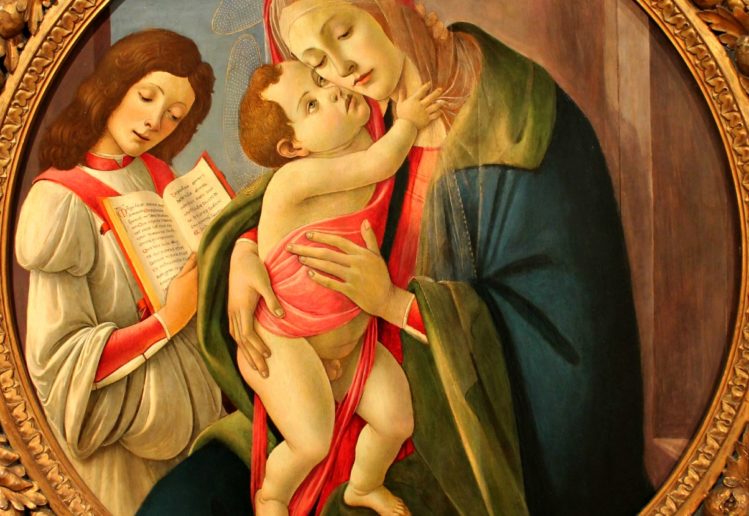Alessandro di Mariano Filipepi, called Sandro Botticelli (and studio)
Madonna and Child with an Angel (“Madonna of the Magnificat”)
Tempera on panel
55 1/8” in diameter x 4/12” deep
On loan from the Bob Jones University Museum & Gallery
This painting depicts the Virgin Mary holding the Christ Child while an angel stands to her right, displaying a holy book containing the Magnificat, or Canticle of Mary, an early Christian hymn taken from the Gospel of Luke; it is what Mary says during the visit to her pregnant, elder cousin Elizabeth, who is carrying John the Baptist. The piece is believed by many to have come from the hand of Sandro Botticelli himself, but it is likely by someone who studied his technique. Some of the characteristics of this work that can be attributed to Botticelli are the fact that the angel has no wings and the delicate linearity evident in the fingers and features of the figures, as well as in their overall curving sway.
There are multiple versions of the work that are close replicas, yet this piece is considered to be superior to the others, specifically due to the positioning of the Madonna’s fingers on the Christ Child. The way the index finger on her left hand is slightly separated from her middle finger is elegantly mannered, while the reflection of light on the drapery folds is expertly rendered, something difficult to do in the tempera medium. This image shows Mary and the Child with very thin, almost transparent, halos, rendered in a way that does not call much attention to them. Another painting in the gallery, Saint Catherine of Siena, has a similar, thin halo. In that piece, it denotes Catherine’s sanctity, but the subtle rendering lets the viewer know that Saint Catherine is still human. Similarly, here, the halos serve to bring the Mary and Jesus down to earth, displaying their humanity and their physical relationship to each other. This, along with the mother and infant’s tender embrace, allows the work to highlight the role Mary plays in Christ’s life as His mother. The fact that this work is a tondo (a round painting) supports this claim, as tondi were not usually made for churches, but for domestic use, and texts from the period tell us that they were to inspire devotion and exemplary behavior in both mothers and children in their homes. The tondo shape informs the work itself, with Mary and the angel both angling their upper bodies towards each other, along the curve of the panel’s shape.
Audrey Vail

